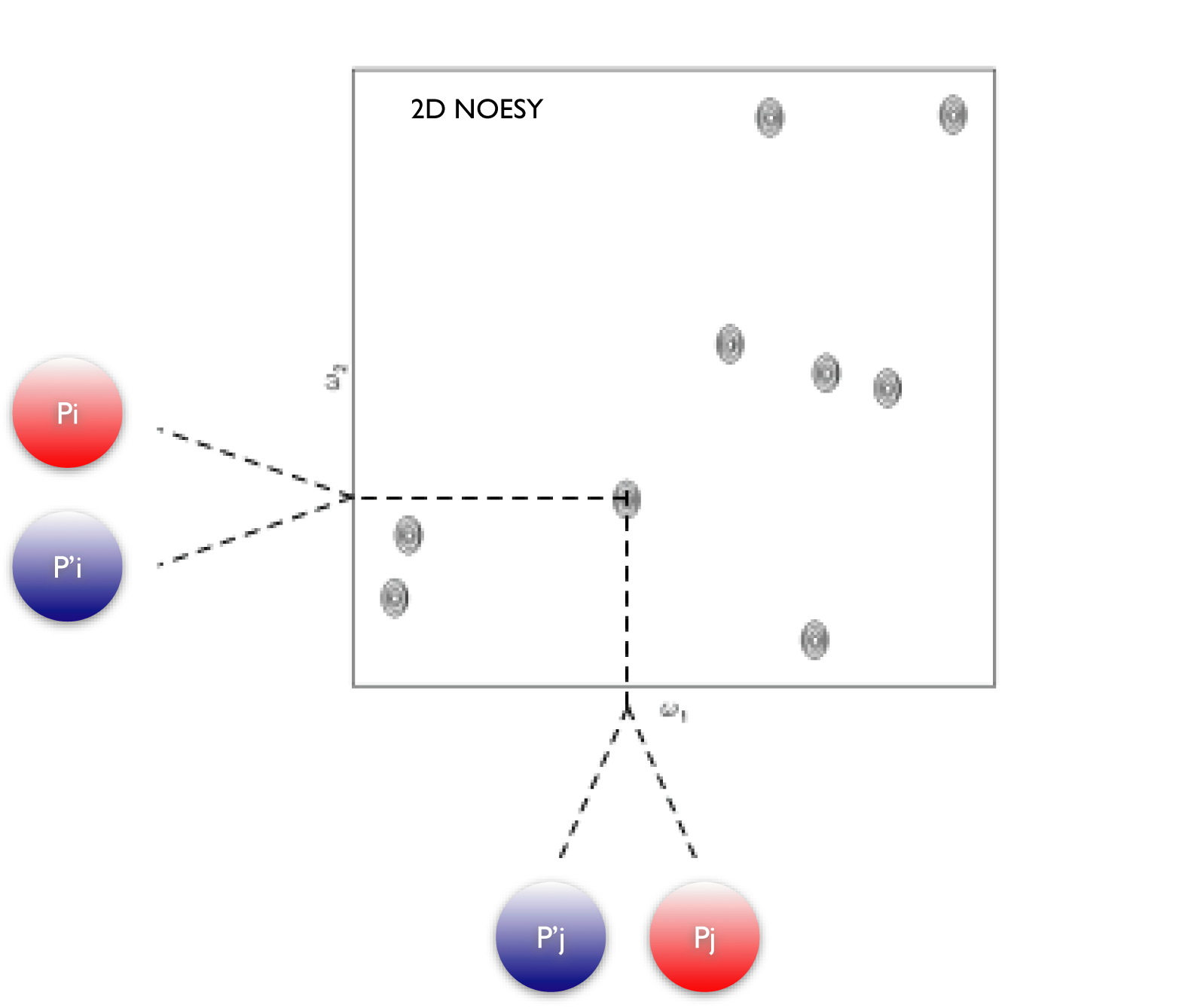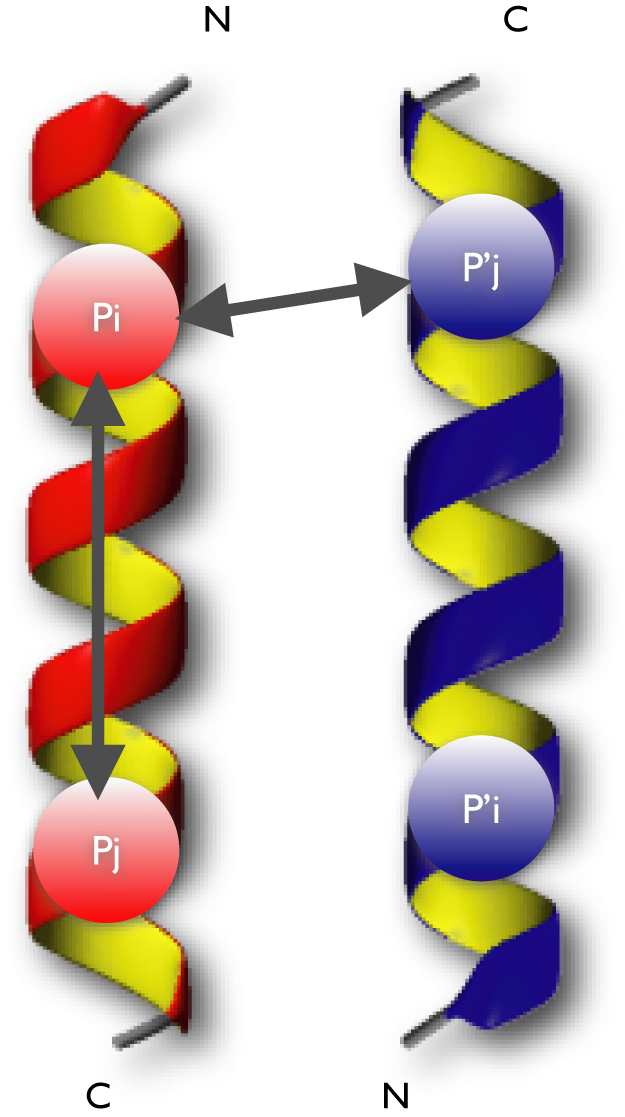Symmetric homodimers
The calculation of symetric homodimers is only available in the version 2.2 of ARIA and later.
Background
The calculation of multimeric structures is a growing domain of the NMR structure determination. Among the complexes, the symmetric homo-dimers occupy a special role in NMR studies, as the chemical shifts of the protons of both monomers are identical. Homodimer NOESY NMR spectra contain intra-monomer as well as inter-monmer NOEs, and it is not possible to discriminate between them on the spectrum:

M Nilges, Proteins 1993, in order to automatically sort between inter- and intra-monomer restraints, and was the starting point of the ARIA development. The principle of the calculation is to defined all restraints as ambiguous between inter- or intra- monomer:

For each peak observed in the spectrum between the chemical shifts corresponding to the spins Pi/Pi' and Pj/Pj', the following ambiguous inter- and intra-monomer restraints will be applied at the beginning of the protocol:

The homodimer symetry is enforced by using the non-crystallographic symetries during the CNS protocol. Furthermore, a packing restraint is applied between the center-of-mass of both monomers, to avoid the separation of monomers during the refinement.

ARIA 2.2 can be used, either to sort inter and intra-monomer restraints in the cas of a predetermined contact map, or to assign NOEs without any prior guess on the structure. In the last case, any additional information about the dimer interface can be essential to enforce the convergence of the calculation. This information can be entered using restraints into the unambiguous.tbl restraint file.
Examples
An example of calculation on a symetric homodimer is given on the flock house virus B2 protein (PDB structure). The protein structure was published by Lingel et al, EMBO Rep 2005. The tarball is homodim_sym.tgz.
The archives for each examples can be downloaded from the site:
- homodim_sym.tgz (version >=2.2)
- homodim_sym2.3.tgz (version >=2.3)
The project directory tree is the same than those already described in the corresponding page.
File format
Conversion xml file
To run a calculation on a symetric homodimer system, it is essential to modify the conversion xml file. Two types of sections have to be filled: the section molecule and the sections spectrum.
In the section molecule, the attribute molecule_segid should contain the two chain ids, seperated by a "/", as for example molecule_segid="A/B":
<molecule
molecule_type="PROTEIN"
molecule_name="sattler"
molecule_segid="A/B"
first_residue_number="1">
<input filename="data/sequence/B2_72_mod.seq"
format="seq" naming_convention=""/>
<output filename="xml/sattler.xml"/>
</molecule>
The, you should specify the ambiguity level of the NOESY experiments, using the attribute spectrum-ambiguity in the element spectrum. If a NOESY spectrum comes from an asymmetric labeling experiment, spectrum_ambiguity should be specified as "inter". ARIA will then consider all the noes from this spectrum as inter-molecular ones. This field is not compatible with the conversion via CCPNMR FormatConverter. The possible values for spectrum_ambiguity are:
- intra (noes involving atoms from one monomer only)
- inter (noes involving atoms atoms from different monomers)
- all (no known information, all noes are ambigous in terms of inter/intra restraints)
If the spectrum_ambiguity is set to "inter" or "all" you must specify the segids of the involved monomers.(e.g., segids="A/B"). If you work on a monomeric protein, you can just leave this field empty, as spectrum_ambiguity is set to "intra" by default).
An example of the section spectrum of the conversion.xml file containing peaks involving both chains, is:
<spectrum
spectrum_name="hnhsqc"
spectrum_type=""
spectrum_ambiguity="all"
segids="A/B">
<chemical_shifts>
<input filename="data/hnhsqcnoe/hnhsqcnoe.ppm1"
format="nmrview"/>
<output filename="xml/hnhsqcnoe.xml"/>
</chemical_shifts>
<cross_peaks>
<input filename="data/hnhsqcnoe/hsqcnoe.xpk"
format="nmrview"
proton1="1"
hetero1="2"
proton2="3"
hetero2=""/>
<output filename="xml/hsqcnoe.xml"/>
<assignments filename=""/>
</cross_peaks>
</spectrum>
If you want to specify the ambiguity of peaks individually, please see details here
Project xml file
Once the conversion is done from the previously described file, and the data files are entered using for example the GUI, the obtained project xml file should contain duplicated elements corresponding to a priori known restraints (hydrogen bonds, dihedrals, residual dipolar couplings, NOEs) existing for each monomer.
<hbonds file="/home/Bis/bardiaux/projects/sattler/data/hbonds/hbondsA.tbl"
format="tbl" ccpn_id="" enabled="yes" data_type="standard"/>
<hbonds file="/home/Bis/bardiaux/projects/sattler/data/hbonds/hbondsB.tbl"
format="tbl" ccpn_id="" enabled="yes" data_type="standard"/>
<dihedrals file="/home/Bis/bardiaux/projects/sattler/data/dihedrals/dihedralsA.tbl"
format="tbl" ccpn_id="" enabled="yes" data_type="talos"/>
<dihedrals file="/home/Bis/bardiaux/projects/sattler/data/dihedrals/dihedralsB.tbl"
format="tbl" ccpn_id="" enabled="yes" data_type="talos"/>
Symmetry related parameters
Several parameters specific to homo-dimers calculations can be set in the project XML file.
Symmetry Data
The Project > Data section contains a section called "symmetry" with the follwing content.
<symmetry enabled="yes" n_monomers="2" symmetry_type="C2" ncs_enabled="yes" packing_enabled="yes"/>
- enabled="yes" means that the molecule defined in the project will be treated as symmetric.
-
n_monomers="2" is to specify the number of monomers (future use)
-
symmetry_type="C2" specifies the type of symmetry of the molecule. ARIA supports C and D symmetry for the moment.
-
ncs_enabled="yes" enables the NCS (Non-crystallographic Symmetry) restraints to minimize RMSD difference between monomers.
-
packing_enabled="yes" activates the use of packing restraints during the simulated annealing.
NCS and Packing restraints behavior can be change in the CNS section of the project.
GUI: Project > Structure Generation > CNS > Annealing Parameters > Symmetry restaints
XML
<structure_generation engine="cns">
<cns local_executable="cns_solve" keep_output="no" keep_restraint_files="yes" create_psf_file="yes"
generate_template="yes" nonbonded_parameters="PROLSQ">
<annealing_parameters>
<symmetry_restraints k_packing_hot="15.0" k_packing_cool1="10.0" k_packing_cool2="5.0" k_ncs="50.0"/>

 ARIA is part of the ELIXIR infrastructure.
ARIA is part of the ELIXIR infrastructure.